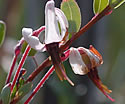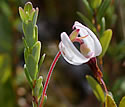Vaccinium macrocarpon (Large Cranberry)
| Also known as: | |
|---|---|
| Genus: | Vaccinium |
| Family: | Ericaceae (Heath) |
| Life cycle: | perennial woody |
| Origin: | native |
| Habitat: | sun; bogs, sphagnum swamps, floating mats |
| Bloom season: | June - August |
| Plant height: | 4 to 6 inches |
| Wetland Indicator Status: | GP: OBL MW: OBL NCNE: OBL |
| MN county distribution (click map to enlarge): |  |
| National distribution (click map to enlarge): |  |
Pick an image for a larger view. See the glossary for icon descriptions.
Detailed Information
Flower: 
![[photo of flowers]](/udata/r9ndp23q/pd3/vaccinium-macrocarpon-006-t.jpg) 2 to 6 nodding flowers on long stalks, arising singly from axils of leaf-like bracts at the base of new shoots, the shoots eventually elongating well above the flowers. Flowers are ¼ to 3/8 inch long, white to pinkish with 4 narrowly lance shaped petals that tightly curl back, like a lily. Projecting from the center is a tight cluster of long, slender reddish stamens and a single, slender style that is longer than the stamens. The stalks are minutely hairy, often reddish with two opposite, tiny scale-like bracts that are typically well above the middle of the stalk.
2 to 6 nodding flowers on long stalks, arising singly from axils of leaf-like bracts at the base of new shoots, the shoots eventually elongating well above the flowers. Flowers are ¼ to 3/8 inch long, white to pinkish with 4 narrowly lance shaped petals that tightly curl back, like a lily. Projecting from the center is a tight cluster of long, slender reddish stamens and a single, slender style that is longer than the stamens. The stalks are minutely hairy, often reddish with two opposite, tiny scale-like bracts that are typically well above the middle of the stalk.
Leaves and stems: 

![[photo of leaves]](/udata/r9ndp23q/pd3/vaccinium-macrocarpon-002-t.jpg) Leaves are simple and alternate, erect to ascending, leathery and evergreen, 1/3 to 2/3 inch long, 1/8 to ¼ inch wide, oblong-elliptic with both base and tip bluntly rounded, toothless, hairless except for sparse hairs around the edge, and short stalked to nearly stalkless. Upper surface is dark green, smooth and shiny with smooth edges that are slightly rolled under; lower surface is pale green, smooth, often with waxy coating.
Leaves are simple and alternate, erect to ascending, leathery and evergreen, 1/3 to 2/3 inch long, 1/8 to ¼ inch wide, oblong-elliptic with both base and tip bluntly rounded, toothless, hairless except for sparse hairs around the edge, and short stalked to nearly stalkless. Upper surface is dark green, smooth and shiny with smooth edges that are slightly rolled under; lower surface is pale green, smooth, often with waxy coating.
![[photo of horizontal stem and shoots]](/udata/r9ndp23q/pd3/vaccinium-macrocarpon-76-8-t.jpg) Branches are slender and wiry, new branches erect to ascending, 4 to 5 inches long, greenish brown to brown, hairy or smooth. Older branches become dark reddish brown and smooth, spreading horizontally 3 to 4 feet, often rooting at nodes.
Branches are slender and wiry, new branches erect to ascending, 4 to 5 inches long, greenish brown to brown, hairy or smooth. Older branches become dark reddish brown and smooth, spreading horizontally 3 to 4 feet, often rooting at nodes.
Fruit: 
![[photo of fruit]](/udata/r9ndp23q/pd3/vaccinium-macrocarpon-730987-1-t.jpg) The fruit is a round berry, 1/3 to 2/3 inch diameter maturing to shiny, dark red, and often persisting through winter.
The fruit is a round berry, 1/3 to 2/3 inch diameter maturing to shiny, dark red, and often persisting through winter.
Notes:
Large Cranberry, also known by synonym Oxycoccus macrocarpus, is the most temperate of our native Vacciniums, common in forested sphagnum swamps throughout central Minnesota, eastward through the Great Lakes, up into New England and the southern maritime provinces of Canada, It is the cranberry of Thanksgiving dinners with central Wisconsin just to our east, the world's top producer. Cultivated berries having been selected over time are typically much larger than what is typically encountered in the wild, but both are equally tart and tasty. While very similar to the more common and more northern Small Cranberry (Vaccinium oxycoccus), they are best distinguished by Large Cranberry's larger leaves that are typically flatter with more rounded tips, and the pair of floral bracts midway or lower on the flower stalk.
Native Plant Nurseries, Restoration and Landscaping Services ↓
More photos
 Large Cranberry plant
Large Cranberry plant Large Cranberry plants
Large Cranberry plants Large Cranberry plant
Large Cranberry plant commercially grown Large Cranberry
commercially grown Large Cranberry a Large Cranberry field
a Large Cranberry field
Photos courtesy Peter M. Dziuk taken in Aitkin and Isanti counties, and at a cranberry farm in Wisconsin.
Comments
Have you seen this plant in Minnesota, or have any other comments about it?
on: 2019-01-05 14:01:26
is it possible to grow this native cranberry here? we have 12 acres deer fenced and a small apple orchard inside, but there are a few acres in what used to be years ago a tamarack&black spruce area.i LIKE the idea of native plants, that is what we strive for here. we are zone 3.
on: 2019-01-05 16:47:40
Michael, you can see from the distribution map this Viburnum is native to your area so there is no reason why it wouldn't grow, providing you have the right habitat, but I don't know where you might obtain starter seed or plants. Just don't take from the wild, please.






